| Article ID | Journal | Published Year | Pages | File Type |
|---|---|---|---|---|
| 10162949 | Pediatria Polska | 2013 | 9 Pages |
Abstract
Donors are key component in transplantation. There are no transplantations without donors. As in any medical procedure, donors are subject to risk of medical complications. An increasing number of stem cell transplantations is observed continuously. In the middle of 2013, a total number of almost 22 million unrelated donors have been registered worldwide, including 440 thousand Polish citizens. In 2012, the ratio of transplants from Polish donors reached 50% among all unrelated transplants performed in our country. Before the stem cell collection, the donor has to be assessed for risk of disease transmission to recipient, safety of stem cell collection for donor and full understanding of stem cell donation. There are 2 methods of stem cell collection: bone marrow harvest and peripheral blood stem cell apheresis. Bone marrow harvest is a standard of care in children, while peripheral blood stem cell collection in adults. Donation of stem cell is a safe procedure for donor. Nevertheless, mild adverse events are relatively frequent, however disappearing in most cases within several days after the collection. The number of requests for stem cell donation is increasing, also for the second or third donation from the same donor. It results in growing medical experience and donors' safety. Although medical progress and standards of patients care contribute to systematic decrease of adverse events for donors, the risk still exists. This should not be the reason for anyone to withhold an agreement for stem cell donation for the sick patient waiting for stem cell transplantation. This analysis presents new insight on safety and prophylaxis of risk of adverse events in children undergoing bone marrow harvest.
Keywords
Related Topics
Health Sciences
Medicine and Dentistry
Dermatology
Authors
Jan StyczyÅski,
